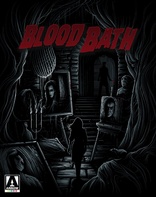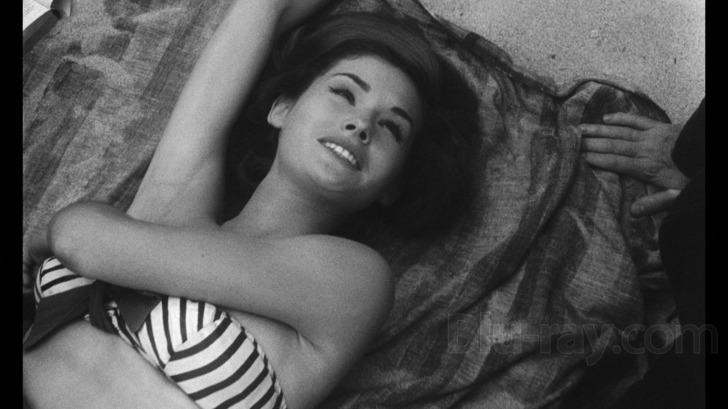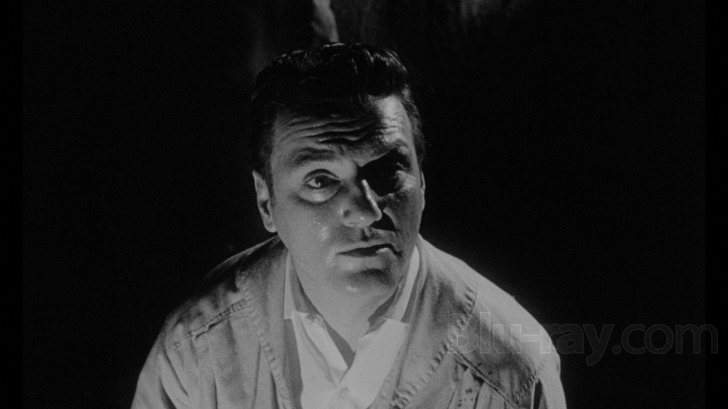Blood Bath Blu-ray Movie
HomeBlood Bath Blu-ray Movie 
Arrow | 1966 | 1 Movie, 4 Cuts | 317 min | Not rated | May 31, 2016
Movie rating
6.2 | / 10 |
Blu-ray rating
| Users | 3.5 | |
| Reviewer | 3.5 | |
| Overall | 3.5 |
Overview
Blood Bath (1966)
A crazed artist who believes himself to be the reincarnation of a murderous vampire kills young women, then boils their bodies in a vat.
Starring: William Campbell (I), Lori Saunders, Sandra Knight, Karl Schanzer, Biff ElliotDirector: Jack Hill, Stephanie Rothman, Radoš Novaković
| Horror | 100% |
Specifications
Video
Video codec: MPEG-4 AVC
Video resolution: 1080p
Aspect ratio: 1.67:1
Original aspect ratio: 1.85:1
Audio
English: LPCM Mono
Subtitles
English
Discs
Blu-ray Disc
Two-disc set (2 BDs)
Playback
Region A, B (locked)
Review
Rating summary
| Movie | 3.0 | |
| Video | 3.5 | |
| Audio | 3.0 | |
| Extras | 5.0 | |
| Overall | 3.5 |
Blood Bath Blu-ray Movie Review
Or, when the 'making of' is more interesting than the actual 'of'.
Reviewed by Jeffrey Kauffman May 26, 2016Sometimes the story of the production of a film (or in this case, films) can be more entertaining than the actual film (or in this case, films) being watched. While this new Arrow Video release is being marketed under the name Blood Bath, it actually contains what amounts to four different films: the one sharing the release’s title, along with Operation Titian, Portrait in Terror and Track of the Vampire. All of the films share footage and at least the semblance of a storyline, but they’re also markedly different in emphasis and tone. That said, probably none of the four is ever going to make a Top Ten (Four?) list on any horror fan’s “must see” agenda, which is why unpacking how this odd concatenation of linked releases ever came to be in the first place is such a fascinating tale. Luckily this release also contains a wonderful documentary by Video Watchdog’s Tim Lucas (updated from his original Video Watchdog articles), a guy who was instrumental in discovering the long unknown (or at least unexplored) connections between the films. Listening to Lucas recount his childhood adventures as a boy watching one of his region’s first independent television stations and realizing that two of the films being broadcast had a lot of the same footage in them, albeit in completely different ways, is a sweet and nostalgic trip to a time when there was no internet to instantly detail the most picayune matters about the most arcane subjects. What makes this story even more remarkable is that for whatever reason a lot of the creatives behind the various projects either never really cared about the fruits of their labors, or had simply moved on to other projects, more or less forgetting about this weird combo platter of films culled from at least some of the same source material. That made Lucas’ investigative efforts a bit more of a challenge than, say, the (much later) exegesis of what went wrong with The Island of Dr. Moreau, as documented in Lost Soul: The Doomed Journey of Richard Stanley's Island of Dr. Moreau.

Would you be able to locate Dubrovnik on a map or globe if you were asked to? Many folks probably wouldn’t be able to, which is one reason why there’s some humorous “travelogue” information inserted into at least one of the versions of the films assembled in this set, information which gives a bit of a clue to some of the labyrinthine machinations which gave rise to Operation Titian and, subsequently, the three “follow ups” which were rejiggered from elements cut and pasted from the first film. None other than the legendary Roger Corman was actually responsible for Operation Titian, or at least the English language version that ultimately was forged out of it (that’s right — there are even more versions of the source material). Corman, evidently trying to extricate himself from what he felt was an economically untenable position at American International, had been trying to make new production deals globally as a producer, and one of those entailed buying distribution rights for what was an as yet uncompleted Yugoslavian entry called Operation Titian. Unbeknownst to many American audiences, American International had already been in the habit of appropriating Soviet bloc films, inserting American actors, and then releasing the cobbled together elements as “new” films (kind of like the way American producers took the Japanese Gojira, edited in sequences featuring Raymond Burr, and “created” Godzilla). Perhaps because of simmering political tensions at the time, these efforts were kept on the down low, and that proclivity seems to have played into at least some of the mystery surrounding the genesis of what ultimately became Blood Bath.
At any rate, part of the deal Corman crafted was to bring over some people associated with Dementia 13, including William Campbell, Patrick Magee and a little known script supervisor named Francis Ford Coppola. Even those considerable talents evidently couldn’t salvage the basic material, and the original Operation Titian was deemed unreleasable by Corman, though (according to Lucas) mostly for reasons that the film didn’t have a proper “hook” for Western audiences rather than any inherent structural or stylistic deficiencies. Without spoiling part of the fun of the story (and even getting to Operation Titian is a rather circuitous tale in and of itself), what happened is that Corman’s protege Stephanie Rothman reshaped the film as Portrait in Terror, which evidently was sold as part of an AIP television package in the mid-sixties and began airing around 1967. In the meantime, Corman had returned to the project and brought Jack Hill on to try do something with it, which resulted in the first version of Blood Bath, which once again did not meet with Corman’s approval. More material was shot (evidently by Rothman), and that version finally got a very brief theatrical release in 1966, some five years after the whole crazy adventure began. But, wait, you also get— when it was determined that Blood Bath’s relative brevity wasn’t long enough for most broadcast television airing opportunities, the film was recut with added elements as Track of the Vampire. Got that? (Don’t worry if you don’t— Lucas’ informative visual essay is always at the beck and call to refer to for a refresher.)
What this boils down to is that there are two versions of two very different films. Operation Titian and Portrait in Terror are crime films, more or less, with a long lost Titian providing a kind of caper aspect, though one that is dotted with a patently insane artist named Sordi (William Campbell). Blood Bath and Track of the Vampire, on the other hand, inject a whole new slew of horror elements, twisting the Titian element considerably in the process and instead playing up a kind of Mystery of the Wax Museum aspect that is largely missing from the first two versions, not to mention introducing a vampiristic sidebar for Sordi's character. That particular addition may remind some viewers of certain elements in Plan 9 from Outer Space, insofar as by that point in this lengthy production process William Campbell was no longer interested in doing reshoots, and so a completely new actor was brought on board to impersonate him (more or less, anyway). It’s all patently goofy stuff to begin with, and the more you know about the transformations that created each individual version, the more patently goofy it all becomes.
What’s really fascinating about all of this is that the source material is surprisingly rather incredibly stylish, obviously highly influenced (as Tim Lucas discusses) by Orson Welles (I’d add German Abstract Expressionism and Welles’ The Third Man collaborator Carol Reed to the list, as well). Framings are often Baroque (to say the least), as are the European locations, and the film suggests both the Carol Reed classic as well as (in one climactic moment, at least) Welles’ own The Stranger. The later accretions rarely match the style of the original Yugoslavian elements (directed by Radoš Novaković), though at least one of Hill’s set pieces comes close. While the resulting versions are kind of inevitably hodgepodges, there are generally quite winning performances and (in the horror outings at least) some gruesome moments that should satisfy fans of that particular genre. No amount of compelling content on screen could probably ever match the intriguing behind the scenes story of Blood Bath, though, and it’s that story that may well offer the most appeal to film fanatics in this new set from Arrow.
Blood Bath Blu-ray Movie, Video Quality 

Blood Bath (in all of its versions) is presented on Blu-ray courtesy of Arrow Video with AVC encoded 1080p transfers in 1.67:1. As is
usual (and commendable), Arrow's insert booklet provides a nice accounting of the provenance of elements utilized for the various transfers
and how those transfers were accomplished. I won't quote in full from the booklet, but details are given about the complexity of this project,
given the fact that so many different versions exist, and that elements are in vastly different shape for those variants. Portrait in
Terror, Blood Bath and Track of the Vampire were all restored in 2K, with Portrait in Terror being source from
(quoting from the booklet now) a "35mm composite fine grain element" and Blood Bath being sourced from "a 35mm fine grain positive
struck from the original camera negative". Blood Bath's final reel was evidently sourced from what the booklet calls "poorer alternate
source materials", with a noticeable downtick in quality. Track of the Vampire, which in essence is a kind of padded Blood Bath,
was sourced as much as possible from the Blood Bath restoration, with additional elements coming from both a dupe negative as well
as fine grain positive elements. The booklet doesn't detail anything about Operation Titian, but the slipcase states that it is "a brand
new reconstruction using original film materials and standard definition inserts".
So, with all of that out of the way, how does it all look? In terms of consistency, I'd probably rate Portrait in Terror at the top of
the list, with Blood Bath and Track of the Vampire more or less tied for second (for different reasons), and Operation
Titian coming in a pretty distant last. There are density issues and slightly wavering contrast on display throughout all four presentations,
and some recurrent crush in the darkest scenes shared by all four as well. That said, Portrait in Terror boasts a relatively homogenous
look throughout, something that probably helps it to elide some of the more obvious deficiencies in the other three presentations. Blood
Bath looks rather good until that aforementioned last reel, when detail, contrast and black levels all suffer. Track of the Vampire
has a more variant heterogenous appearance throughout its presentation, obviously due to the different elements utilized create it. There's a
slightly wider variation in grain structure in this presentation as well. Operation Titian is a real curiosity (from any number of
standpoints), and simply can't compete with the other three presentations due to the insertion of standard definition material, which looks to
have been sourced from video elements (at least some of the time). This is the most "patchwork quilt" looking of the four versions, with the
film elements looking at least decent, though at times very badly damaged.
Note: Screenshots are arranged in the following way:
Blood Bath: Screenshots 1, 5, 9, 13, 17
Track of the Vampire: Screenshots 2, 6, 10, 14, 18
Portrait in Terror: Screenshots 3, 7, 11, 15, 19
Operation Titian: Screenshots 4, 8, 12, 16
Blood Bath Blu-ray Movie, Audio Quality 

There's not quite the disparity in quality in the LPCM Mono tracks adorning all four films as there is in the video quality. That said, the baseline quality of these tracks is occasionally problematic, with distortion being noticeable in musical cues at times. Dialogue comes through relatively cleanly and clearly, but all four tracks are pretty shallow sounding, though without any deal killing damage to report. It's obvious that at least parts of all four versions were dubbed and/or post-looped, for there's a (perhaps charming) disconnect between lip movements and actual dialogue at times.
Blood Bath Blu-ray Movie, Special Features and Extras 

Note: All of the supplements are found on Disc 2 of this two disc set.
- The Trouble With Titian Revisited (1080p; 1:21:13) is Tim Lucas' delightful and extremely interesting breakdown of the various versions and the rather convoluted tale behind them. This is a great starting place for those who haven't seen any of the films (let's face it, these aren't masterpieces capable of being "spoiled" by plot summaries), or a charming opportunity for comparison for those who may have seen at least one version previously.
- Bathing in Blood with Sid Haig (1080p; 4:36) is a brief but fun interview with the actor.
- Jack Hill on Blood Bath (1080i; 3:06) features archival video of the iconic director.
- Gallery (1080p)
Blood Bath Blu-ray Movie, Overall Score and Recommendation 

Blood Bath is a really fascinating release, though perhaps for some "meta" reasons rather than the films themselves. There's fascinating content in the films, at least in dribs and drabs, but what will appeal to cineaste sleuths is seeing how the source material was bended and remolded to create such disparate entries. Lucas' appealing visual essay is icing on the cake (and/or wax on the body, as it were). Arrow continues to mine the more hidden niches of cultdom and create really winning releases. Highly recommended.
Similar titles
Similar titles you might also like

Humanoids from the Deep 4K
1980

Invasion of the Blood Farmers
1972

Nude for Satan
Nuda per Satana | Remastered Edition
1974

The Incredibly Strange Creatures Who Stopped Living and Became Mixed-Up Zombies
1964

The Mutilator
1985

Blood from the Mummy's Tomb
1971

Night of the Demons
Collector's Edition
1988

Empire of the Ants
Kino Cult #11
1977

Hollywood Chainsaw Hookers
1988

Silent Scream 4K
1979

Night Tide
1961

Blood Feast
1963

Vampyros Lesbos
Special 2-Disc Limited Edition
1971

Rabid 4K
Collector's Edition
1977

The Possession of Joel Delaney 4K
Slipcover in Original Pressing
1972

The Night Evelyn Came Out of the Grave
La notte che Evelyn uscě dalla tomba
1971

The Gruesome Twosome/A Taste of Blood
1967

Prom Night
Special Edition
1980

Blood Rage
1987

Demons 2
Dčmoni 2... l'incubo ritorna
1986